Hello,
Welcome to today’s edition of Kitchen Projects. Thank you so much for being here.
A few weeks ago I asked you: When is the right time to receive a newsletter about Christmas Cake? And you all said: ASAP. So, friends, I’m thrilled to hand you over to the inimitable Camilla Wynne. I mean, WHO ELSE would we trust with christmas cake?! Her St Clements version is just gorgeous.
On KP+, Camilla is sharing two Christmas Cake adjacent recipes. These will be perfect for anyone who isn’t “sure” about Christmas Cake, or just wants to dip their proverbial toe into the Christmas Cake pool before committing to the large size: Fruitcake in a Jar (ADORABLE) and Christmas Cake Cookies! Click here for the recipes.
What’s KP+? Well, it’s the level-up version of this newsletter. By joining KP+, you will support the writing and research that goes into the newsletter (including the commissioning - and fair payment - of all the writers), join a growing community, access extra content (inc., the entire archive) and more. Subscribing is easy and only costs £6 per month or £50 for the whole year. Why not give it a go? Come and join the gang!
Love,
Nicola
SIFT: COMING OUT IN TWO DAYS!
It’s hard to believe that my debut book SIFT: The Elements of Great Baking will finally be out in the US and Canada in two days. I’m currently in the US and so excited to see it here in bookshops and to meet you on tour (which is now… sold out! more info below).
Packed with recipes and in depth reference sections, it is available to pre-order now! I’m also heading to the US on tour (click here for more info) - I can’t WAIT for you to finally get this book, and hopefully to see you soon!
SIFT ON TOUR
I’m thrilled that the ticketed book talks and demos for the SIFT US tour have… sold out! BUT there are still lots of fun events that I hope to see you at:
SEATTLE
Tuesday 12th November
Book Larder demo & talk with Rachael Coyle of Coyle’s Bakeshop (SOLD OUT)
SIFT x Kemi Dessert Bar limited edition collab box - (ORDERS CLOSED)
Wednesday 13th November
Guest pastry at Coyle's Bakeshop
SAN FRANCISCO
Thursday 14th November
Omnivore Books talk with Nicole Accettola of Kantine SF - not ticketed, just come by! The wonderful Maria Zizka, who americanized sift (more from her sooon!) is making some treats from SIFT, too!
LOS ANGELES
Saturday 16th November & Sunday 17th November
Brunch & Pastry SIFT specials at Botanica. ft. canele, whipped feta cheesecake tarts with red walnuts, savoury spiced pumpkin buns and bread and butter pudding french toast! book here.
Sunday 17th November
Book Talk at Now Serving LA with Nicole Rucker (SOLD OUT)
NEW YORK
Tuesday 19th November - NYC
Archestratus Books + Food - Book talk with Natasha Pickowicz - (SOLD OUT)
MINNEAPOLIS
Thursday 21st November
Bellecour at Cooks of Crocus Hill - Baking masterclass Tickets (WAITLIST ONLY)
Saturday 23rd November
Book signing and pastry collab at Diane's Place - menu TBA
On Fruitcake
I was (and still am) the weird kid whose favourite ice cream was rum raisin and I would pick a Rum & Butter chocolate bar over Snickers or Mars. So, I suppose it makes sense that I was one of the few kids I knew for whom fruitcake was a seasonal delight that I looked forward to every year. Dark, squidgy, a mass of dried and candied fruit punctuated by nuts and fuming with rum, it’s still one of the holiday traditions in which I take the utmost delight.
Sadly, in the US fruitcake has something of a bad reputation, no doubt due to the poor-quality mass-produced specimens on offer. I still remember being shocked when my father showed me the ingredient list on one such cake—made not of fruit but tasteless candied turnips! This isn’t true across the board, of course. Some Southern companies have been doing excellent business selling mail-order fruitcakes since the early 20th century, and I was surprised to learn that there’s still a significant production of fruitcakes in American monasteries (who knew?). The expression "nutty as a fruitcake" dates from around 1935, apparently owing to the large quantities of nuts in Southern cakes. Fruitcake was ridiculed on late-night tv, made a wasteful sport of in fruitcake-throwing competitions, and even used as a gay slur (Mayukh Sen writes beautifully about the latter for Food52).
Fortunately, the US isn’t the center of the universe. A British invention, there’s not a wealth of information on the history of fruitcake, but it can’t have arrived on the scene much before the Middle Ages, as dried fruits, the main and eponymous ingredient, only began arriving in Britain in the 13th century from Portugal and the eastern Mediterranean. In fact, it was probably originally known as a lightly fruited bread, as dried fruits and spices were luxuries, and yeast was the main cake leavener until the mid-18th century. It likely resembled European fruited breads such as panettone and stollen. Early versions, such as Scottish black bun, were reserved for special occasions and celebrations, much as fruitcake still is. Popular in the UK, Canada, Bahamas, Australia, the US, New Zealand and India (one can clearly see how colonialism played a part here), fruitcake typically appears during Christmas celebrations, though it did enjoy a good run as the standard wedding cake and is certainly enjoyed by some aficionados on a more regular basis, particularly in India.
From Scottish Dundee cake to Caribbean black cake to American white fruitcake, variations abound, but they’re always considered dense and rich (that said, an improperly aged fruitcake can be dry–they need feeding and caretaking!). Interestingly, there’s actually relatively little fat in a fruitcake. Its reputation for richness is more likely related to its high proportion of ingredients that were very costly—dried fruit, nuts and spices, not to mention liquor. Dried and candied fruit and nuts account for around 40-60% of the cake, so it really is just fruit barely bound together by cake, a ratio of 1:1 fruit to batter!
And depending on what fruits, nuts, spices and spirit you use, you can create a totally different cake. Classic fruitcakes tend to contain raisins, currants, candied peel and perhaps glacé cherries; Brazil nuts or almonds; warm spices like cinnamon, nutmeg and ginger; and brandy or rum. You might, however, try a more stripped-down version with one star ingredient. For instance, dried and candied pears, walnuts, allspice and pear liqueur, perhaps sweetened with maple sugar. The possibilities are truly endless!
The deal with aging
Fruitcake is typically aged for at least a few weeks, and often much longer. Often wrapped in cheesecloth and foil, perhaps tucked into an old tin, it's kept somewhere cool and dosed regularly with spirits, which help preserve it.
Oddly, that fruitcake is usually aged can be one more strike against it for its detractors, in the same way they might malign a century egg. That the same people probably venerate 10-year-old Scotch and consider 3-year-old cheddar superior to its non-vintage counterparts just goes to show how random (and hypocritical) that criticism must be.
To me, the process of aging makes fruitcake even more special, denoting forethought in its preparation, a bit of ritual and care. While I know some people prefer unaged fruitcake (and was surprised to find in my Christmas pudding research that I might actually prefer that fresh), I am firmly on team aged fruitcake. A fresh fruitcake is often charming, with distinct flavors more easy to identify, as they haven’t yet melded into the singular flavor aged fruitcake– dark, sticky, boozy and mysterious. At least with my recipes, the spirit is an integral part of the flavor, and it takes time to fully imbue a dense cake. (For the folks who don’t drink alcohol: You can soak the fruit mixture in tea or juice to make a non-alcoholic cake, for it to last a long time the alcohol is essential in keeping microbes at bay).
I love the melding of all the disparate parts into one compact whole. That said, I usually make my cakes sometime in October to serve in December. Once they’ve aged beyond 6 months I can subconsciously tend to regard them with a little bit of suspicion, in spite of the fact that they remain perfectly edible. I suppose I’m still trying to shake off the residue of my exposure to anti-fruitcake propaganda!
Currently I am tending two mini fruitcakes (Fruitcake in a Jar - recipe on KP+!) that are approaching 11 months of age. Like the marmalade I made from calamansi I grew and that is now at least 6 years old, the older the fruitcake gets, maybe the more rare and special it seems to become and, therefore the more inclined I am to continue saving it rather than savoring it. I think the oldest I’ve let a fruitcake get is about 15 months, but if fed with alcohol occasionally, it can theoretically last many more years. A fruitcake dating from 1878 has been kept as an heirloom by a Michigan family, with the great-great-granddaughter of the baker now in charge of the cake’s continued well-being. In the right conditions, even a fruitcake without a custodian a fruitcake might survive a century. The Antarctic Heritage Trust discovered a 106-year-old cake in reportedly excellent condition, albeit with the dubious merit of smelling “almost” edible.
Aging a fruitcake is hardly a chore. I like to wrap my freshly baked cakes in a few layers of alcohol-soaked cheesecloth (typically dark rum or brandy, though a particular recipe may call for something else), in order to create a sort of absorbent cloak. I’ll then either keep them snugly in an airtight container or resealable freezer bag, somewhere out of the way and not too warm. In the first enthusiastic month I’ll feed them by sprinkling in more alcohol on a weekly, placing my thumb partially over the mouth of the bottle and shaking my arm around, but beyond that feeding tends to devolve to whenever I remember to, and they seem to do okay. To be fair, I have a pretty good memory.
Decorating
Now that you have your aged fruitcake (or unaged, as you like), it’s time to contemplate how you’ll bring it to the table. Unadorned, it is a sort of stodgy-looking dark brown, mottled with raisins and currants, much like its cousin, the Christmas pudding, but without its high drama of arriving aflame.
Traditionally, fruitcake is finished with a layer of marzipan, adhered with apricot jam, then sealed with a rock-hard layer of protective royal icing, often stuccoed to resemble drifts of snow. This technique was first put into print by Mrs. Raffald in 1782, but presumably predates that publication considerably.
In Canada, I’ve almost never encountered this finish on a cake. Some of the cheap grocery store cakes came with a thick layer of marzipan on top, but never with the royal icing. It’s not really necessary from a preserving standpoint. If the cake is properly aged, it shouldn’t require being sealed with icing, which I’ve most frequently witnessed being discarded after diners peel it off. Though I do have a personal fondness for eating hardened royal icing, I don’t feel the need to subject others to it. The marzipan, on the other hand, seems like a nice addition—as long as you like marzipan (though I feel most marzipan-haters would also fall in the fruitcake-hating camp, making it a moot point).
One of my favorite arguments for the marzipan layer comes from the headnote for Liberation Fruitcake in The Alice B Toklas Cookbook: “[A layer of almond paste] is not gilding the lily, it is only bringing its perfume more pronouncedly to your attention.” While this is difficult to argue with, I usually present my fruitcake entirely without decoration, feeling that those who love it don’t need convincing by way of physical beauty. That said, I did teach a class last year where we decorated my mini fruitcakes (Fruitcake in a Jar recipe) with royal icing and topped them with homemade marzipan fashioned to look like forest fungus or oysters with pearls or green fruits and vegetables, depending on the maker, and they were absolutely stunning packaged in clear boxes tied with bows. An excellent option for a gift.
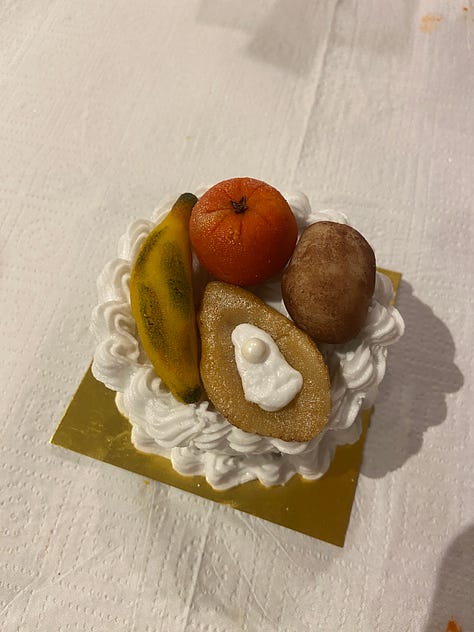
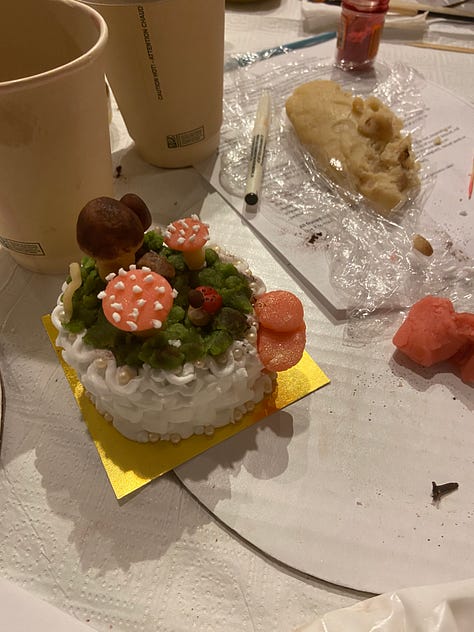
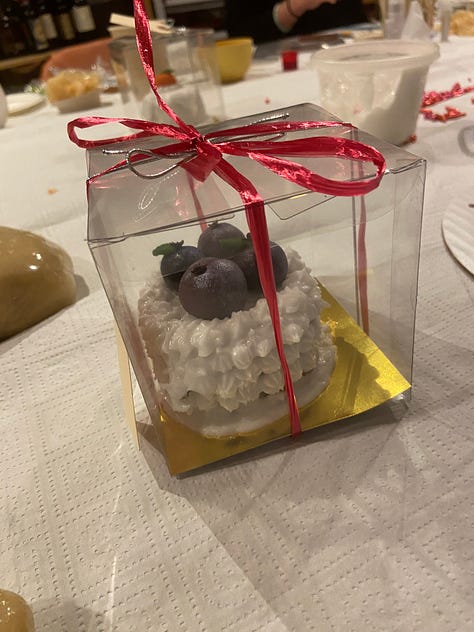
Or perhaps my favorite fruitcake presentation I’ve ever seen was from a Nigella cookbook, where the entire surface of the low, round cake was artfully covered edge to edge in a mosaic of glistening candied fruits and nuts. I’ve taken inspiration there for the finish on my St Clemens Fruitcake.
Serving
As I say, I most often serve my fruitcake unadorned in thin slices as an afternoon or after-dinner treat during the holidays. That said, even this simple offering can sometimes take a little forethought, depending on how enthusiastic you’ve been about feeding your cake.
Growing up, the very best fruitcake I knew of was my Aunt Sue’s (she, also, of the mincemeat tart pastry perfection). That said, she had a hand as heavy with the rum as my second-year pastry school teacher (which is to say massive), and so before we would enjoy it, my father insisted on airing it out for at least a few days, its wrappers loosened in the cool basement as it off-gassed. (By contrast, my teetotaling maternal grandmother’s cakes greatly benefitted from an extra few weeks soaking in spirits.)
Pastry chef and writer Bronwen Wyatt argues to include fruitcake on cheese plates. Pairing fruitcake with cheese is apparently common in the UK. In North Yorkshire, it’s served with Wensleydale, which I’d never considered, but it sounds quite good. You should read her article if you need convincing, but it does make sense, considering what a good friend cheese is to fruit and nuts. That said, I’ve never tried it! What can I say? Old habits die hard.
I like how, during the holidays, treats are so bountiful that even when there isn’t a big centrepiece dessert being served—your trifle or your bûche or what have you—one still daily cobbles together a little plate of treats. Cookies, chocolates, confections—and fruitcake. To me, this is where it best belongs. Not the star of the show, but a stalwart presence, anticipated annually with fierce fondness, always served unadorned to better appreciate the complexity of something made with such great care and forethought by someone who loves both it and you.
RECIPE: St Clement’s Fruitcake
St Clement’s is flavor shorthand for citrus, from the English nursery rhyme “Oranges and Lemons”: “Oranges and lemons say the bells of St Clement’s” it goes. I’ve always loved that little rhyme, and I wanted to create a fruitcake that was a little more pared down, highlighting one flavor and just accenting with spice and dried fruits. The addition of nuts is very subtle, in the form of almond flour. A clementines puree lays the citrus foundations right in the batter and ensures a moist crumb, and the cake is punctuated by candied orange and citron, which should be homemade or the best you can afford. Even if you enjoy an unaged fruitcake, you’re going to want to age this one at least a few weeks, as much of its sweetness is provided by the orange liqueur with which it’s fed.
Ingredients
250 g golden raisins (sultanas?)
170 g diced candied citron (or lemon)
170 g diced candied orange
105 g diced dried apricot
90 g brandy
255 g clementines (~3)
220 g brown sugar
85 g unsalted butter, at room temperature
70 g honey
1 egg
1 yolk
160 g all-purpose flour
75 g almond flour
¾ tsp baking powder
½ tsp freshly grated nutmeg
½ tsp ground gloves
½ tsp kosher salt
Orange liqueur, for feeding
Candied citrus, nuts, marmalade and fresh bay leaves, to decorate
Method
The day before you plan to bake, in a medium bowl, combine golden raisins, candied citron, candied orange and apricot. Add brandy and mix well to combine. Cover and set aside at room temperature overnight.
Place clementines in a small pot in a single layer. Cover with water so that they float freely, then put on a lid. Bring to a boil over high heat, then reduce to medium and simmer until fruit is soft, about 1 hour. Remove from heat and let cool in the pot at room temperature overnight.
The next day, drain clementines, stem and halve to remove any seeds (we are using the whole thing, peel and all!), and puree in a blender or food processor.
Preheat oven to 350° / 160c fan
Grease a 9x5-inch loaf pan and line with parchment paper.
In a large bowl, cream brown sugar, butter and honey until well-combined. Beat in egg, then yolk, then clementine puree. Sift in flour, almond flour, baking powder, nutmeg, cloves and salt. Fold in until just combined. Fold in fruit mixture.
Transfer batter to prepared pan and bake until a toothpick inserted in the middle comes out clean, about 90-120 minutes depending on your oven. If the cake is getting too dark, cover loosely with foil. Cool completely on a wire rack.
Saturate a large piece of cheesecloth in orange liqueur. Remove cake from pan and wrap in cheesecloth, then place in a large resealable freezer bag or airtight container.
For the first few month of aging, sprinkle the cake generously with orange liqueur every week. After that, just do it whenever you remember—every 3 or 4 weeks is fine.
Before serving, if desired, place on a platter and decorate the top with candied citrus fruits and peel (and whole nuts, if you like). If desired, brush with warm strained marmalade for shine and cohesion then tuck in some fresh bay leaves for a pop of green.






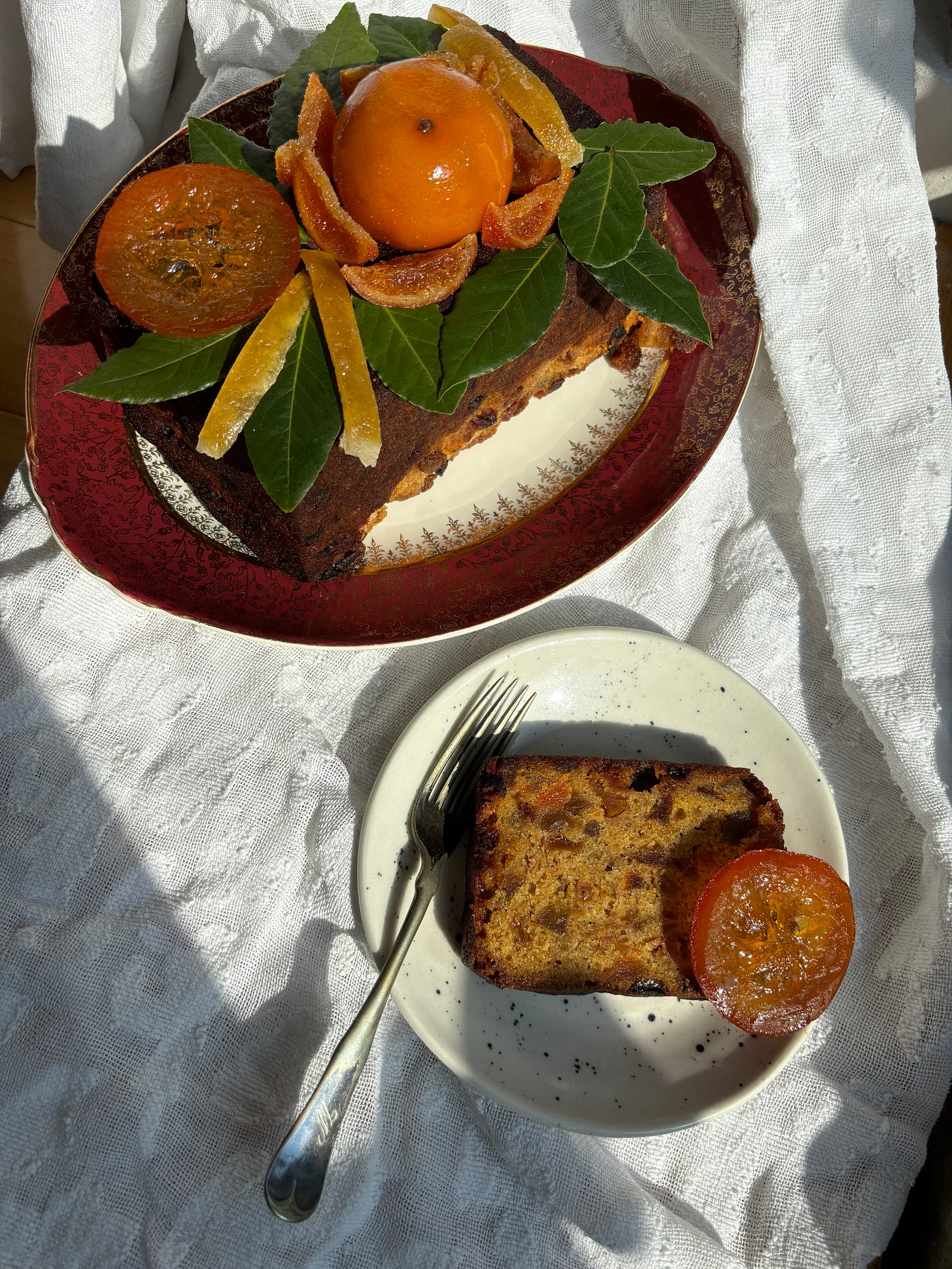
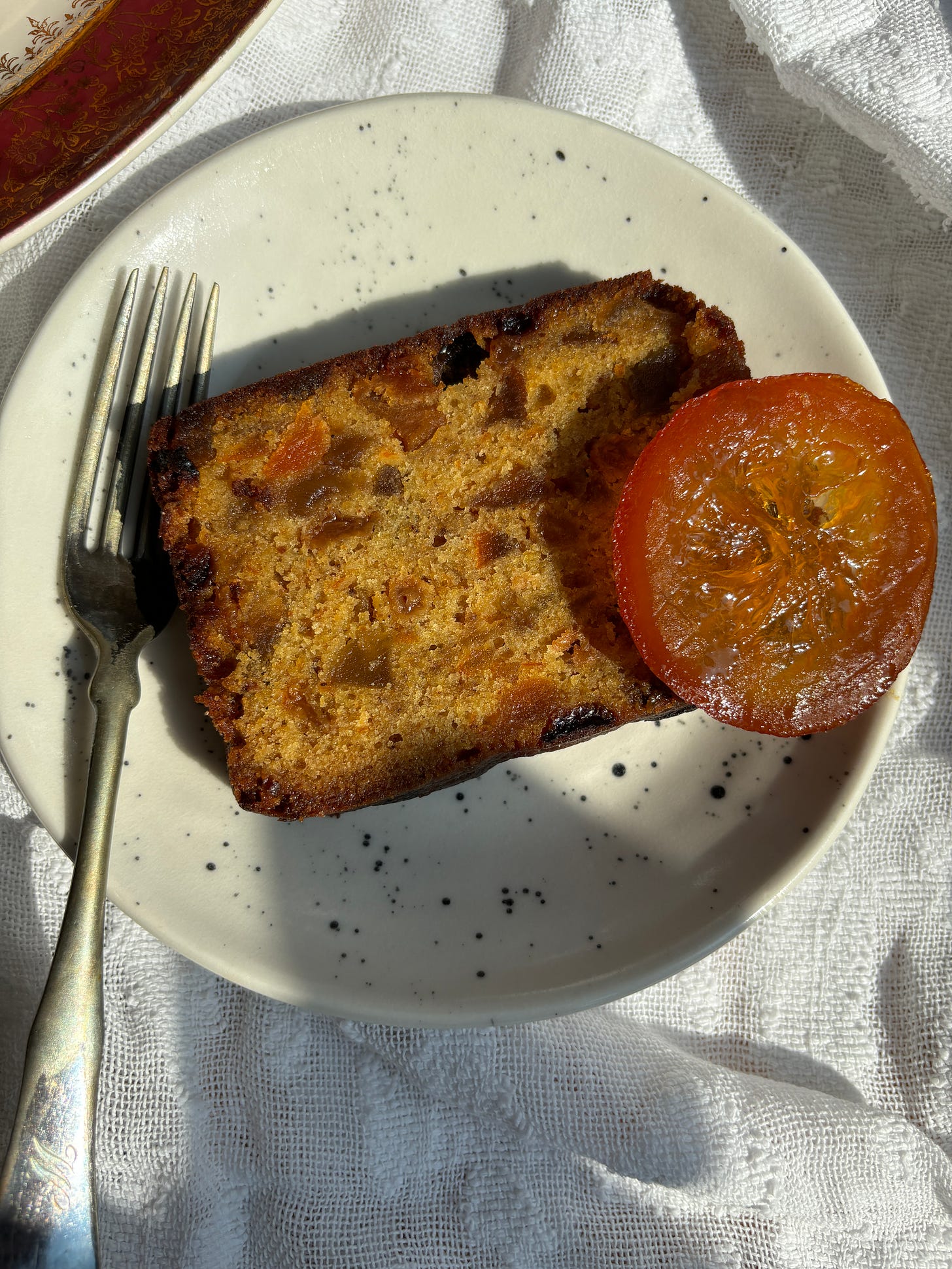
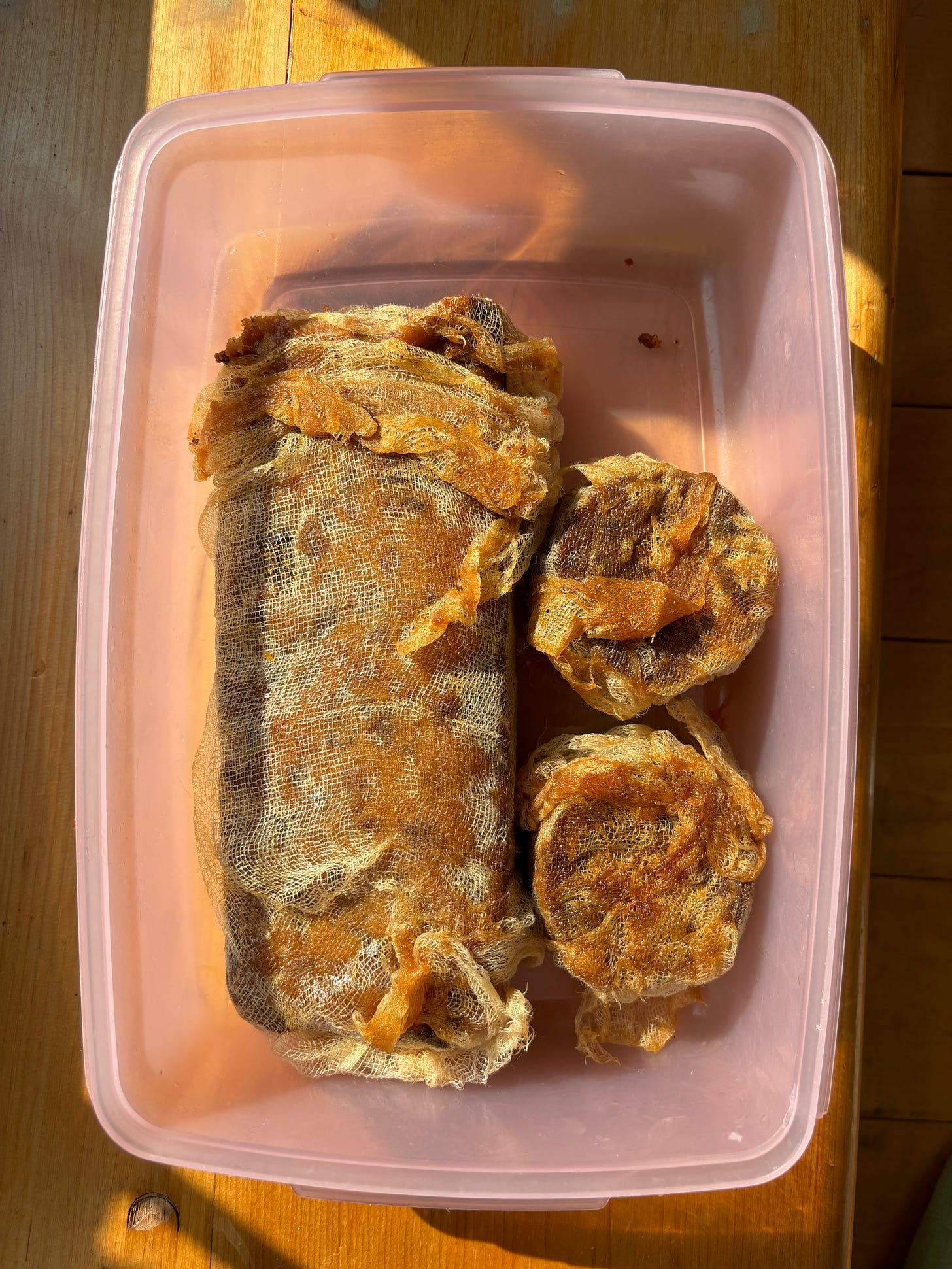
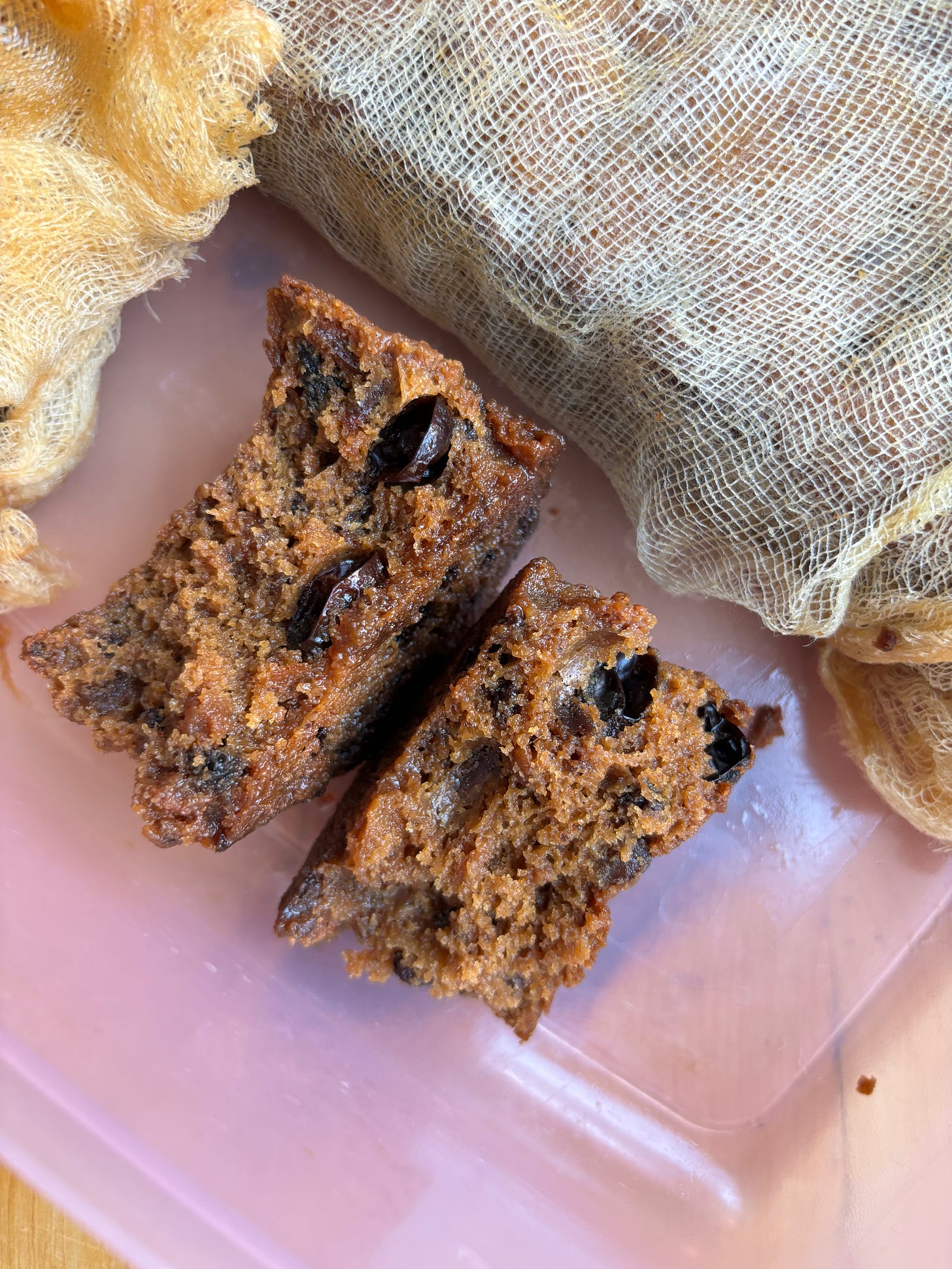
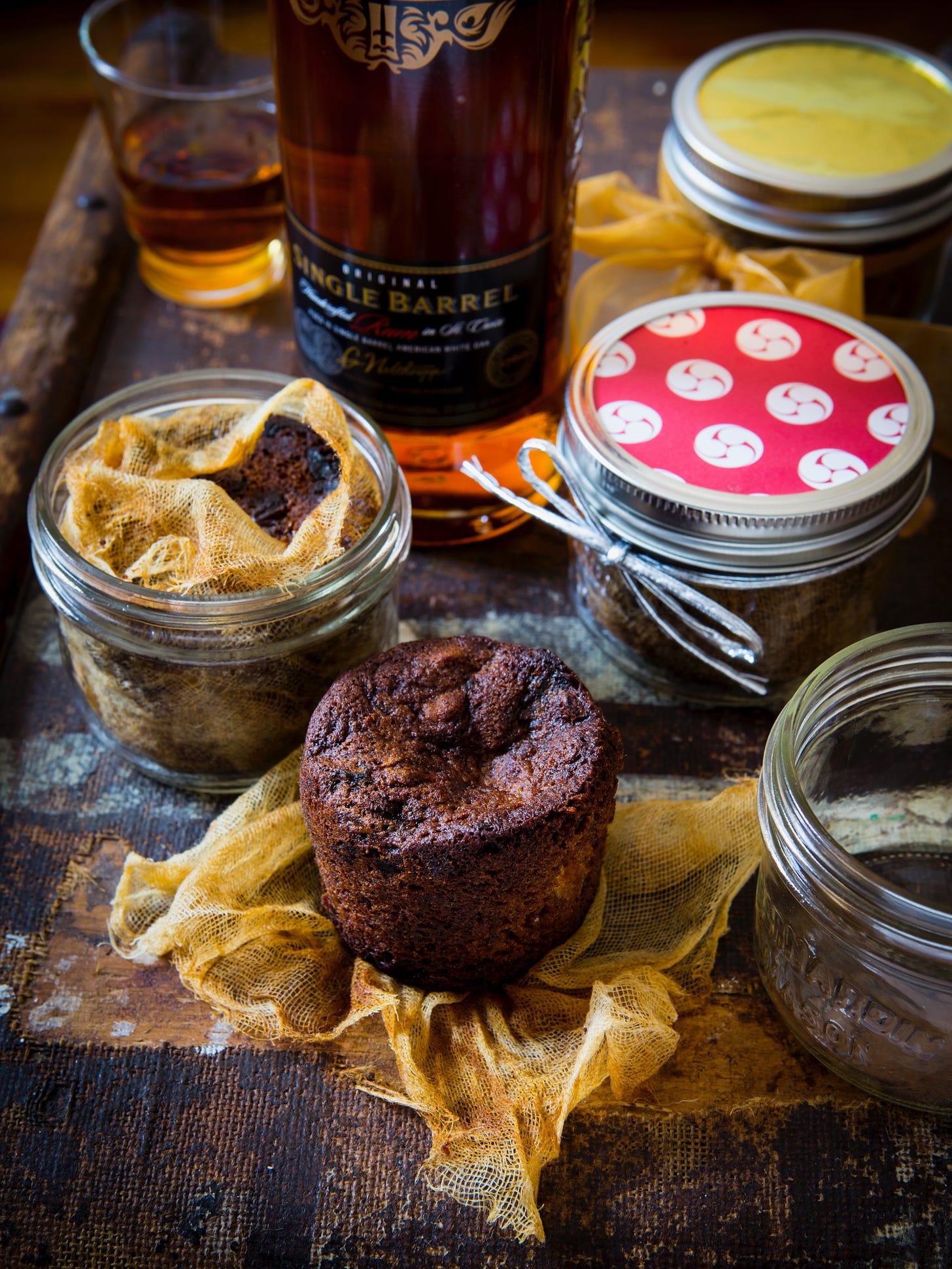

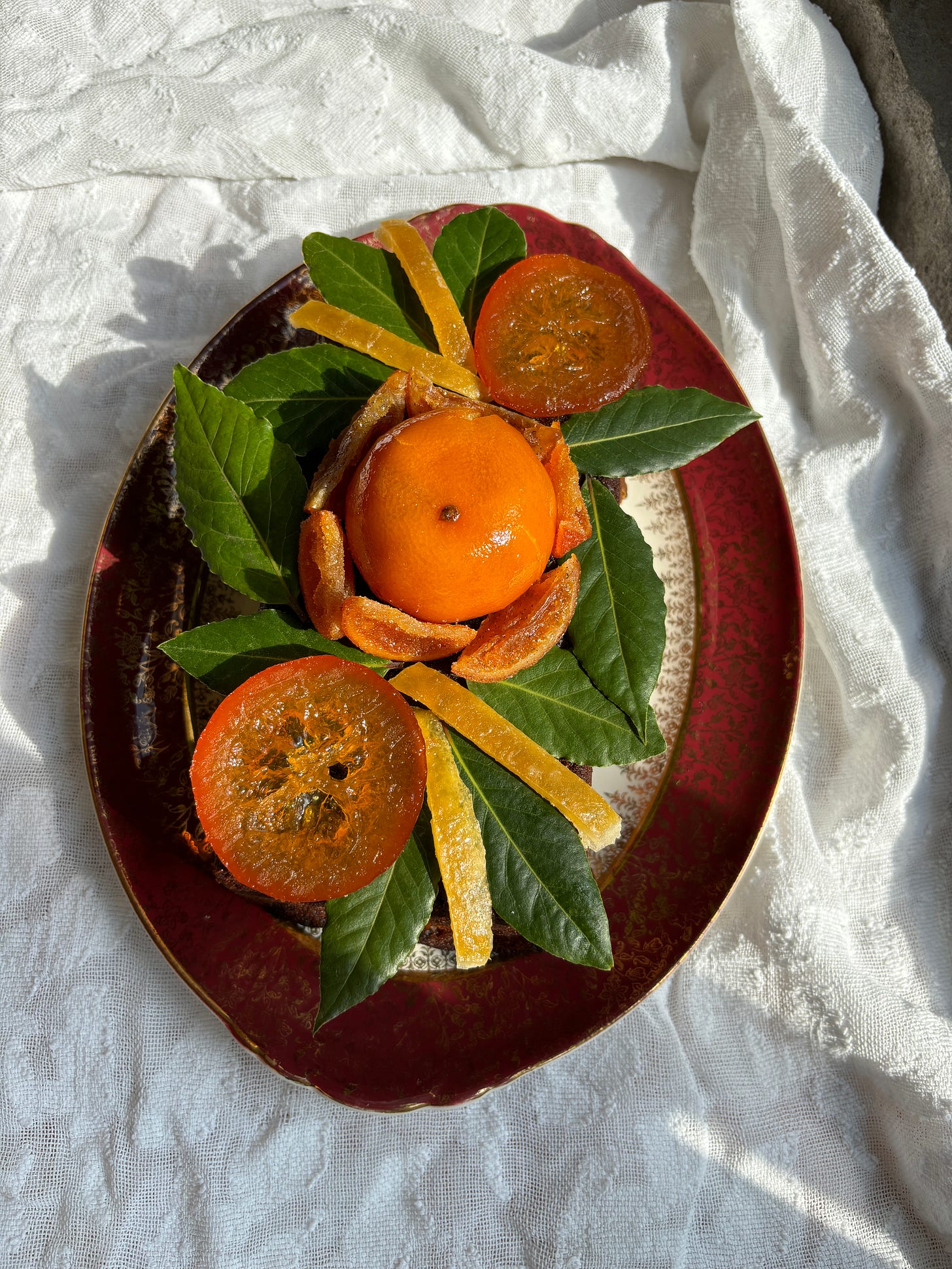
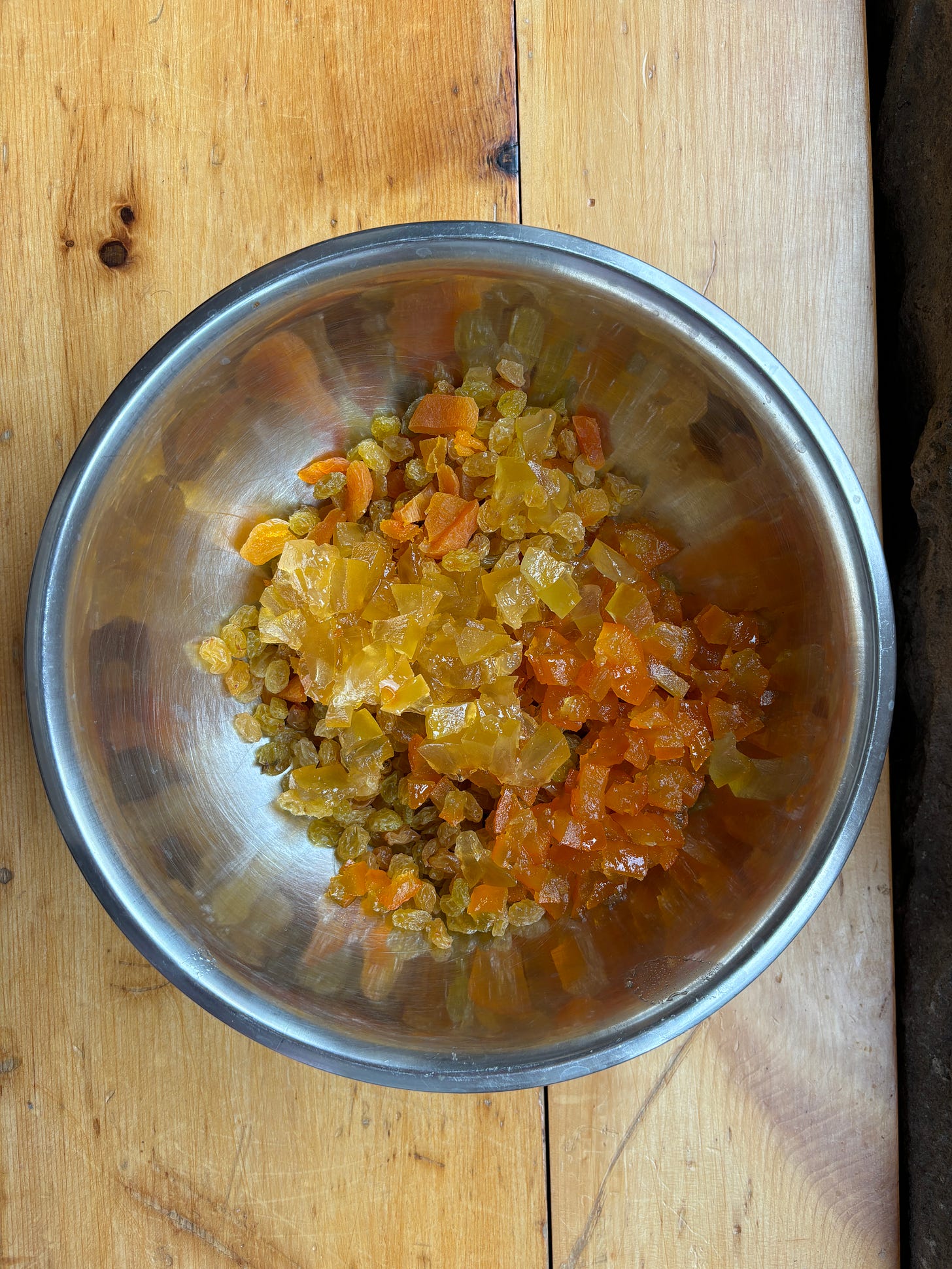
This is why I love Substack. Thoughtful, intelligent and amazing articles and authors. Perfect timing. I’m attempting my first fruit cake. My father loves fruitcake, or I should say the idea of fruitcake, since I doubt he’s ever had a real one, so I’m making this his Christmas present. After researching dozens of recipes, I’ve settled on one and I began my fruit soaking yesterday with hopes of baking this evening. I have a quick question if you wouldn’t mind. I used Ohio made spiced rum to soak, which hopefully is a good choice, but I’m torn about what alcohol to feed with. Any thoughts on feeding with spiced rum or should I feed with triple sec like Cointreau or some sort of brandy? I’m willing to buy your suggestion. Also, the recipe calls for orange & lemon zest and orange juice. I was between that recipe and one that used unfiltered apple cider and some orange zest. I’m concerned about then orange being too overpowering? Does the citrus mellow in your recipe after aging? I would greatly appreciate your thoughts. Btw, I was thinking of trying to come up with a fruitcake that was stripped down with some of the flavors I prefer so your idea of a pear & walnut is intriguing. I’d love to see a recipe for that one.
I never seem to have the time to make a Christmas cake, but I have plenty of memories from the 60s and 70s in Australia.
My mum always made one - we each had a stir for luck - and hers were always decorated by studding the top with blanched almonds in a pattern.
One year in high school home economics we made and decorated a fruit cake, with the apricot jam/marzipan/royal icing layers. It was an enormous amount of work to get all the layers smooth and level. The cake was cooked in the traditional tin lined with multiple layers of paper - I don't know why, but it was only done with fruit cakes; other cakes only got one layer. The paper used was called butchers paper - basically the paper used to print newspapers, but unprinted of course.
I've also had them with candied citrus slices decorating the top.
Good bakers here usually make excellent cakes, and if any are left over, they're usually an excellent purchase shortly after Christmas. If you're looking for a desert option in the lazy days between Christmas and New Year, a slice with a scoop of ice cream is very tasty.